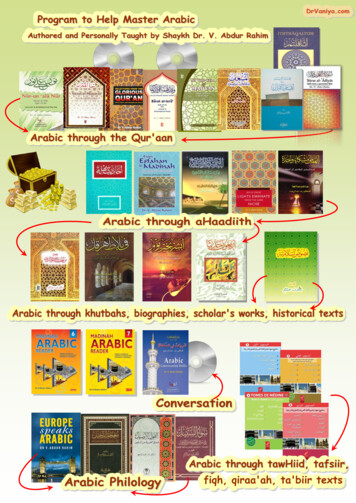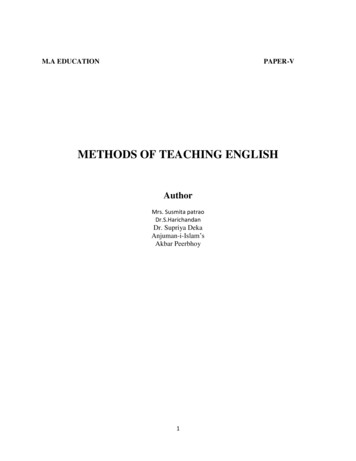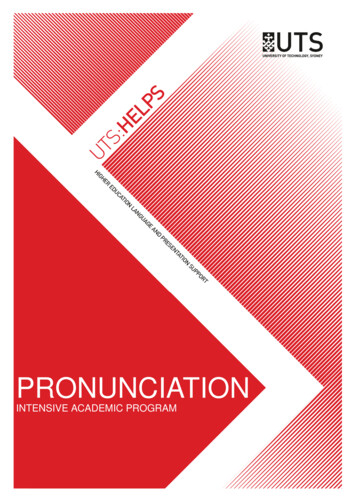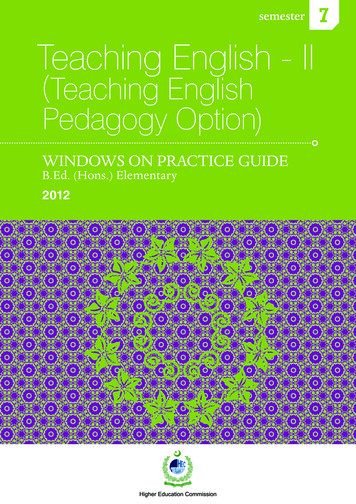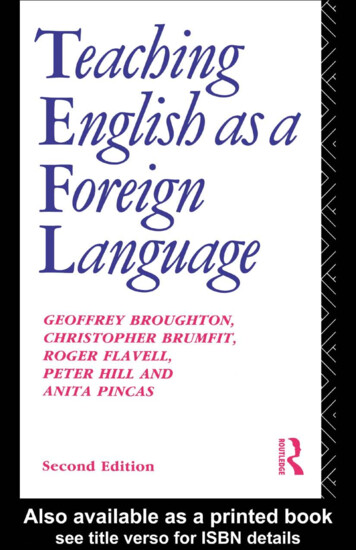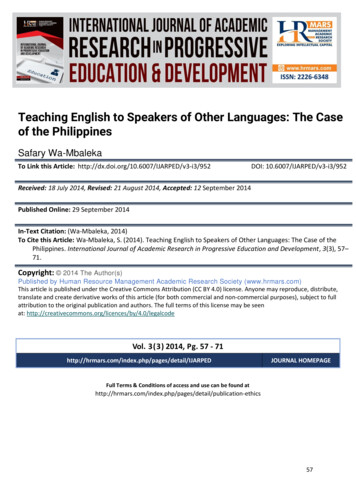
Transcription
International Journal of Academic Research in Progressive Education andDevelopmentVol. 3 , No. 3, 2014, E-ISSN: 2 2 2 6 -6348 2014 HRMARSTeaching English to Speakers of Other Languages: The Caseof the PhilippinesSafary Wa-MbalekaTo Link this Article: http://dx.doi.org/10.6007/IJARPED/v3-i3/952DOI: 10.6007/IJARPED/v3-i3/952Received: 18 July 2014, Revised: 21 August 2014, Accepted: 12 September 2014Published Online: 29 September 2014In-Text Citation: (Wa-Mbaleka, 2014)To Cite this Article: Wa-Mbaleka, S. (2014). Teaching English to Speakers of Other Languages: The Case of thePhilippines. International Journal of Academic Research in Progressive Education and Development, 3(3), 57–71.Copyright: 2014 The Author(s)Published by Human Resource Management Academic Research Society (www.hrmars.com)This article is published under the Creative Commons Attribution (CC BY 4.0) license. Anyone may reproduce, distribute,translate and create derivative works of this article (for both commercial and non-commercial purposes), subject to fullattribution to the original publication and authors. The full terms of this license may be seenat: deVol. 3(3) 2014, Pg. 57 - JOURNAL HOMEPAGEFull Terms & Conditions of access and use can be found tion-ethics57
International Journal of Academic Research in Progressive Education andDevelopmentVol. 3 , No. 3, 2014, E-ISSN: 2 2 2 6 -6348 2014 HRMARSTeaching English to Speakers of OtherLanguages: The Case of the PhilippinesSafary Wa-Mbaleka, EdD, PhDAdventist International Institute of Advanced Studies, Silang, CaviteEmail: wa-mbalekas@aiias.eduAbstractIn the Philippines, English is an official language. It is used as a medium of instruction. Yet,most Filipinos learn English as an additional language because they have various mothertongues. The diverse linguistic backgrounds of Filipinos create a challenge for both Englishteachers and learners of English as an additional language. As all linguists continue to think ofinnovative ways to teach English to speakers of Filipino languages, the Philippine contextpresents some particular factors that must be taken into consideration today. This studyexplored the strengths, weaknesses, opportunities, and threats (SWOT) to the teaching ofEnglish as an additional language in the Philippines. Results show that English teaching andlearning in the Philippines has been successful in general but has areas for improvement.Results are based on data collected from eight individual written interviews conducted withEnglish educators, linguistic leaders and experts of Teaching English to speakers of OtherLanguages in the Philippines. The study also presents some practical recommendations forEnglish language education policies in the multi-lingual societies of the Philippines.Keywords: TESOL, Philippines, Strengths, Challenges, Threats, Mother-Tongue-BasedEducation, EnglishIntroductionThe Philippines is a nation that is leading English proficiency in Asia in general. SeveralEnglish survey reports from both the academe (Tupas, 2000) and the business world(GlobalEnglish Corporation, 2012), and other aspects of life (Kirkpatrick, 2010) are pointingmore and more to the importance that the English language and English proficiency areplaying in the educational success and economic boom of the Philippines as well as othersurrounding nations. Despite the great linguistic diversity of the country, English continuesto receive high functional popularity in the different areas of daily life in the nation.The instruction and improvement in proficiency of English in the Philippines, however,have met quite some challenges in recent years. Among many others, there are new lawsemphasizing more mother-based instruction, the limited number of higher educationinstitutions that offer specific academic preparation for the teaching of English to learnerswhose mother tongue is other than English, technological advance, and limited instructionalresources for some educators and learners.58
International Journal of Academic Research in Progressive Education andDevelopmentVol. 3 , No. 3, 2014, E-ISSN: 2 2 2 6 -6348 2014 HRMARSIn the Philippines, only two higher educational institutions currently offer someacademic degrees in Teaching English to Speakers of Other Languages (TESOL) as of 2013.More than 180 local Philippine languages are spoken in this country. The new law thatpromotes mother-tongue-based education in K-12 has just been passed a couple of years ago.The goal of internationalization of education in the Philippines continues to make waves inthe academic arena. A strong connection is developing among the members of theAssociation of Southeast Asian Nations (ASEAN), using English as a lingua franca. Filipinos (thepeople of the Philippines) are traveling all over the world to provide work labor in differentfields. Most of them have to use English to travel and work abroad. More and more countries,including Asian, African and Latin American countries, are sending their students to thePhilippines because of English as a medium of instruction in the country. Looking at thehistorical background of the Philippines, English ties the past to the future of this nation.The Philippines is in a state of rethinking and re-conceptualizing how and why Englishmust be taught and learned in the Philippines. The situation is so complex that no one seemsto know exactly what to do. This study aimed at contributing to the discussion by synthesizingthe input of some experts, policymakers, and practitioners of English teaching in thePhilippines.Theoretical FrameworkThis study is based on different second language acquisition (SLA) models andtheories. The multiplicity of SLA theories considered in this study reflects the complexity ofthis topic. The study relied especially on five major theories: Kachru’s Model of English Circles,academic successful learning in mother tongue, globalization calling for English, Krashen’sInput Hypothesis and Critical Hypothesis theories.Kachru’s English CirclesThe spread of English around the world has created different opportunities to exploreit from different perspectives. Kachru wanted to classify the different types of English basedon its function, learning, and teaching around the world. This classification of world Englishesled to the classification of all the nations of the world in three different circles: the Inner Circle,the Outer Circle, and the Expanding Circle (Kachru, 1985, 1990; Kachru et al., 2009).Accordking to Kachru, the Inner Circle is comprised of countries where English is thenative language of most of the speakers. The United States of America, England, and Australiaare all in this first circle. As a group, these are known as the true native speakers of English.The Outer Circle is made of countries where English is used as a lingua franca, mediumof instruction, for professional and academic purposes. This is usually in context where mostnationals use different mother tongues. They use English because they inherited it from thecolonizer and because it is one of the best ways to linguistically unify people of the samenation. This is where the Philippines, Nigeria, India, South Africa, and Singapore are found. Inthese contexts, English covertly plays a political role of creating equality among speakers ofdifferent mother tongues.In this context, there seems to be a continuous struggle for the balance betweenEnglish and the local languages, English and whatever is chosen as the national language. Itbecomes even more complex in a country like the Philippines, with so many local languages.The last circle, the Expanding Circle, is made of countries that are introducing Englishin their systems. In this context, English is spoken as a foreign language. It is hard to hear59
International Journal of Academic Research in Progressive Education andDevelopmentVol. 3 , No. 3, 2014, E-ISSN: 2 2 2 6 -6348 2014 HRMARSpeople speak English on the streets of these countries. It is the case of countries likeMyanmar, Indonesia, Peru, and Ivory Coast.Learning in the Mother TongueBased on research that has shown that people learn better in their mother tongue,the Philippines recently passed a law that requires early grades to use one of the 12 nationallanguages as the medium of instruction. This number started at 8, then moved to 12, and injust 2 years after the application of the law, some are calling for 14 languages. It is true thatresearch has proven a direct link between academic success and studying in the mothertongue (L1). It is, however, unknown how this works when a country has multiple firstlanguages (multiple local languages).Indeed, it has been shown that students who study in their mother tongue are fast inrecognizing words and learning vocabulary in their own mother tongue (Abadzi & Prouty,2012). Additionally, comprehension is at best in most of the subjects that students take, andcognitive development is effective when studying in the mother tongue (Alfari, 2009; Changizi& Shimojo, 2005; Thomas & Collier, 1997). Last, applying these theories of learning throughL1, the study by Ledesma and Morris (2005) yielded positive results of Filipino students whostudied in Tagalog as their mother tongue.It is true that the link has been established for effective learning in mother tongues. Itis probably one of the reasons why important quality is seen in education of South Korea,Japan, China, and the United States (Pinar et al., 2006), where students study primarily in theirmother tongue. One factor between all these nations, however, is that nationals of the samecountry share primarily only one language, unlike the Philippines that has a plethora of locallanguages. Additionally, these countries are already fairly economically stable that they donot have an urgent need to integrate English or other Western languages in their systems foreconomic survival.Globalization’s Call for EnglishAnyone embracing globalization today is de facto expected to integrate English in thenational system. Looking at the ASEAN countries (in the Southeast region of Asia), the increasein the integration of English instruction is unprecedented (Kirkpatrick, 2010). English is therope that will tie these nations together due to the great linguistic diversity observed there.Today, economics, travel, tourism, and written texts heavily rely on English. Tocompete on the global market, the nation must have a strong command of English. In fact,the survey on the Business English Index revealed that the high index of business English inthe Philippines correlated with its strong economic growth in 2012 (GlobalEnglishCorporation, 2012).As for travel and tourism, the primary medium of communication found in hotels,restaurants, banks, recreation areas, flights, airports, among many others, is English. With therapid spread of information technology, English is overused today through social networks,books, journals, signs, television, radio, etc. English’s imperialism (Finegan, 2011), a conceptthat seemed illusionary a few decades ago, is real today. The Philippines cannot be free fromthe integration and promotion of English if the nation plans to continue thriving in the globalpolitical and economic competitiveness.60
International Journal of Academic Research in Progressive Education andDevelopmentVol. 3 , No. 3, 2014, E-ISSN: 2 2 2 6 -6348 2014 HRMARSInput Hypothesis and Critical Period HypothesisIn the early 1980s, Steven Krashen, one of the great theorists of language learning,developed a number of theories. For the purposes of this study, two have been taken intoconsideration: The Input Hypothesis and the Critical Period Hypothesis. These two areespecially important for the topic under consideration because of their relevance.According to Krashen (Krashen, 1981, 1985), for people to learn a language, they mustreceive input (through reading). To be able to produce a language correctly, one must havehad access to comprehensible input. Put into the context of this study, for Filipinos to learnEnglish well, they must receive considerable amount of English at school. It is true that theyreceive English input through other channels, such as television, radio, websites, and socialnetworks. They still need, however, academic input in an academic setting. Krashenrecommends flooded input for learning to occur.According to the Critical Period Hypothesis (Birdsong, 1999; Nunan, 2009), there is acertain age beyond which human beings are not able to reach the full potential of learning anadditional language. Although the specific age is debated, most linguists agree that beyond acertain age (varying between puberty and end of adolescence), people face quite somechallenges in fully learning an additional language. Proponents of critical period believe thatthe earlier the introduction of a new language, the better in second language learners. Basedon this hypothesis, it would be necessary for countries in the Outer Circle to introduce andemphasize both the mother tongue and English early in the life of the students. Such anapproach would most likely help develop simultaneous bilinguals (Foote, 2010), an approachpreferred over sequential bilingualism when considered from the Critical Period Hypothesis.How all these theories come together in the discussion of the TESOL challenges andopportunities in the Philippines was the basis of the current study. These theories areintriguing in the context of the Philippines. Yet, limited research has been done on them. Dueto heavy emphasis on English literature and English education, English teachers and policymakers treat English as if it was Filipino students’ native language. Although it might be themother tongue of some, from the functional perspective, English in the Outer Circle is notconsidered their mother tongue as a whole. This study tried to shed some light on thiscomplexity of the issue of TESOL in the Philippines. This fundamental understanding couldhelp meet better the needs of English teaching and learning in the Philippines.Research QuestionsAs of 2013, the Philippines had only two universities that were offering a certaindegree in TESOL. All other institutions that trained teachers in teaching English focusedprimarily on English literature and English education, two fields that are not usually suitablein preparing teachers of English to speakers of different native languages. Additionally, a newstudy revealed that the young generation of Filipinos are struggling with both English andtheir mother tongue (Chureson, 2013). They are proficient in neither language. To make theissue even more complex, the Philippines recently passed a law of using native languages asmedium of instruction in early years of K-12 education. With all these complexities, thecurrent study aimed to address the following research questions.1. What is contributing to the teaching and learning success of English in the Philippines?2. What challenges do people face in teaching and learning English in the Philippines?3. What should be the steps forward in the teaching and learning of English in thePhilippines?61
International Journal of Academic Research in Progressive Education andDevelopmentVol. 3 , No. 3, 2014, E-ISSN: 2 2 2 6 -6348 2014 HRMARSResearch DesignDue to the complexity and the goal of the topic selected for this study, several factorswere taken into consideration as described in this section. The interpretive approach ofresearch fit well with the study because of its multiple ramifications. The views and opinionsof the research participants were synthesized to address the different components of thestudy, using a thematic approach.Research DesignThis study is based on the case study design because it sought to explain the “how”and “why” of the present circumstance (Yin, 2014) of TESOL in the Philippines. For thedirection of this case study, the SWOT matrix was utilized to be able to clearly explore andsynthesize the strengths, weaknesses, opportunities, and threats. It proved to be the bestapproach for this specific study because it provided a very specific direction of the study thatwould probably have not been achieved otherwise. Although originally from the field ofbusiness during the economic collapse (Fine, 2010), SWOT analysis is a powerful tool to lookat large systems and organizations.Population and SampleThe population in this study included English practitioners (English teachers,educators, and instructors), English policymakers, leaders and administrators of Englishlanguage institutes, English departments, and English schools. These were considered to beat the forefront of global and local decisions that affect English teaching and learning in thePhilippines.Sampling was purposive. As recommended for purposive sampling in qualitativeresearch (Creswell, 2013; Lichtman, 2012), participants were selected if they were found tobe able to provide the best information available on the teaching and learning of English inthe Philippines. Although it can be prone to bias, purposive sampling is commonly used inqualitative research. It gives the researcher an opportunity to choose the most effectiveinformant available for the study.The sample of this study included eight participants. While representativeness is nota recommended characteristic of qualitative research, diversity of English language teachingexperts was considered in the selection of the research participants. This was purposefullydone to base the findings of this study on the overlap between people from differentpositions.The participants included the president of the TESOL Philippines professionalorganization, one Regional English Language Officer Assistant (at the United States Embassyin Manila, Philippines), two chairpersons of English departments offering graduate subjectsin TESOL, two university English professors, one English language institute director, and oneEnglish teacher. This diversity helped collect data that might be relevant to the differentgroups of experts involved in the design and delivery of English instruction in the Philippines.Data CollectionThis study is based on an interview guide that was validated trough its review by oneprofessor of English and three TESOL experts (see Appendix A). The people presented in thesample voluntarily agreed to participate in the study. They were contacted either by email orby phone. They were given a choice of receiving a phone interview or answering the interviewquestions by writing. They all chose to address the questions by writing, except one. They62
International Journal of Academic Research in Progressive Education andDevelopmentVol. 3 , No. 3, 2014, E-ISSN: 2 2 2 6 -6348 2014 HRMARSbelieved that by writing their answers, they could think more about the questions before theycould return their answers. They were each given two weeks to develop and submit theiranswers to me by email.Data AnalysisData analysis was based on content analysis that used the emerging themes. Anyconcept or category that was mentioned at least three times in the data was considered inthe results. Additionally, the SWOT matrix was considered to make sure all the componentsof the matrix were included. This was also based on the research questions and the main goalof the study.ResultsFor simpler organization of the findings, the SWOT matrix was used. The findings werelater used to address the three research questions that guided this study. Findings in thisstudy, however, need to be taken with caution due to the nature of qualitative research. Thisstudy was conducted as a baseline study to generate different variables that can now beinvestigated in depth in subsequent research studies.Excluded DataAs indicated above, themes were included in this study if reported by at least threeparticipants. There were some that met this criterion but were excluded because they werenot unique to TESOL; they related to other fields too. When some participants addressedsome weaknesses and threats related to the English teaching and learning in the Philippines,they also discussed general issues such as infrastructure, class size, lighting and ventilation,poverty and hunger, and technological advancement. Although these are all importantfactors, they were not considered in the analysis of this study because they relate to otherfields of learning.StrengthsThe data presented several strengths worthy of consideration in this study. It wasevident that research participants were optimistic about the quality of English teaching andlearning in the Philippines. They based their opinions on the fact that English is used as bothan official language and a medium of instruction, two functions that require a high level ofcommand of the language.They indicated more evidence with the recent study that showed the Philippines asthe best in Business English in the world (GlobalEnglish Corporation, 2012), apart from nativespeaking English nations. Additionally, they indicated that more than 90% of people in thePhilippines now speak English; a considerable percentage of English speakers compared toother surrounding nations. Based on the same organization, the Philippines is considered thethird country with the largest number of English speakers in the world, just after the UnitedStates of America and India. Considering the percentage of English speakers in each of the 10top nations with the largest number of English speakers, the Philippines comes again at thethird place right after the United States and the United Kingdom, while India falls at the endof the list.The additional evidence that they provided was in relation to the high graduation rateof English majors and the fact that an increasing number of people are coming to thePhilippines to learn English. As long as English departments in higher education institutions63
International Journal of Academic Research in Progressive Education andDevelopmentVol. 3 , No. 3, 2014, E-ISSN: 2 2 2 6 -6348 2014 HRMARScontinue to produce English majors, it is evident that English will continue to be taught atschool. That is somehow an important sign of sustainability of English instruction in thePhilippines.As for foreigners who are currently traveling to the Philippines for English, it isevidence that the world is considering the Philippines as a good place to learn English. Englishlanguage institutes are mushrooming in the Philippines. They are drawing students fromdifferent continents. English learning tourism is also growing. People are entering thePhilippines just to enjoy tourism while learning and practicing English. The Philippines is alsotraining English teachers for the neighboring countries, in addition to sending Filipinoteachers to teach English in those same countries and beyond.Another strength was that the country provides access to large amount of English printmaterials, television and radio programs, and considerable amount of Internet access inEnglish. According to them, English is perceived and portrayed positively through the media.The Filipino people have a positive attitude towards the United States, the country thatpassed English on to them. This positive attitude is in line with Krashen’s Affective FilterHypothesis (Nunan, 2009) and even some pragmatics literature that shows that such anattitude is conducive to effective learning of a second language.This positive attitude was evident in other themes that emerged. For instance,someone who speaks English well in the Philippines is considered highly educated.Additionally, English speaking is encouraged at home.WeaknessesThe data demonstrated three major sets of weaknesses that have negativeramifications on English language teaching and learning. These include limited English ofSpeakers of Other Languages (ESOL) materials and curriculum for solid foundation of K-12education, interference of many linguistic backgrounds, and limited number of TESOL experts.These weaknesses have negatively affected the teaching and learning of English in thePhilippines.ESOL materials and curriculum. ESOL materials and curriculum are missing in theteaching and learning of English in the Philippines. Instructional materials used in K-12 do nottake into account that Filipinos, as members of the Outer Circle, are not native speakers ofEnglish. They go to school with their own linguistic backgrounds. They go there to learnEnglish. Therefore, from SLA theories and models, some accommodations are expected tomeet the English language needs of these students. Lack of ESOL materials and curriculum isdue to the high cost that is attached to them and the limited number of trained TESOL experts.The lack of ESOL accommodations in the instructional materials has led to somenegative impact. English language learning is weak at the foundational level (K-12). This weakfoundation has a negative impact on higher education. Tertiary education is expected to relyheavily on English as a medium of instruction in the Philippines. Without solid foundation ofEnglish in K-12, students may be expected to meet some challenges in their learning process.Due to lack of adequate ESOL materials, K-12 may develop English linguistic errors thatgo on unnoticed or uncorrected. Without effective intervention in early years of Englishlanguage learning, students internalize some errors that go on unnoticed for a long time.These errors become quite difficult to correct because students reach what has been knownin SLA as plateau or fossilization (Nunan, 2009). One of the reasons why college professorscannot help their students improve their English is that students’ errors are internalized in K12. Unlearning something is usually harder than learning something new.64
International Journal of Academic Research in Progressive Education andDevelopmentVol. 3 , No. 3, 2014, E-ISSN: 2 2 2 6 -6348 2014 HRMARSLimited trained TESOL experts. This weakness has also some devastatingconsequences on the English teaching and learning in the Philippines. Because of the weakfoundation of English in K-12 and extremely limited number of colleges and universitiesoffering TESOL academic degrees, some English teachers are not well prepared for their workand others have their own fossilized English errors. They can easily transfer these to theirstudents, thus perpetrating the errors over several students and over the years. Some of theseerrors are also internalized through daily communication. As errors are used frequently indaily communication, people begin to use them as the normal linguistic rules. At a certainpoint, people are no longer aware of the errors because they have become fossilized.Interference of different linguistic backgrounds. The Philippines currently has morethan 180 languages. Thus, groups of teachers and students of English come from variouslinguistic backgrounds. They each come with some potential of their own linguisticinterference. Some teachers are reported to be mixing their mother tongue with English whileteaching. In fact, there are some college instructors that cannot teach without using codeswitching. In many cases, this is because code-switching has been fossilized in their English.This code-switching is transferred to the students and the vicious circle goes on.Mother-Tongue-Based Multilingual Education (MTB-MLE) law. The Philippinespassed the MTB-MLE law recently, which requires earlier grades to be taught in students’mother tongues. While learning in the mother tongue is supported by research, it has becomea new weakness for English teaching and learning. Under the MTB-MLE law, the number ofEnglish instruction periods is highly limited. From the Input Hypothesis perspective, it can beexpected that the English learning process will be slower as a result of MTB-MLE. This law isgood for learning in general. Its application, however, is causing some challenges because itis still new and it looks like limited training has been provided to teachers, in this Outer Circlecountry.OpportunitiesMTB-MLE. The Mother-Tongue-Based Multilingual Education law, seen for some as aweakness for the teaching and learning of English in the Philippines, was viewed as anopportunity by others. According to those who believe in its positive aspect, MTB-MLE willhelp students learn better all other subjects in K-12. Additionally, and maybe even moreimportantly for TESOL, English will for the first time be in the hands of TESOL experts.In the previous curriculum, all teachers (even those who could be struggling withEnglish) were expected to teach all the subjects, including English. With MTB-MLE, onlytrained English teachers will teach English. Even if MTB-MLE provides limited time for Englishin earlier grades, this law is expected to yield better results for English language teaching andlearning because English will be taught by experts. It is understood that it is better to havefewer hours of English teaching well done than more hours of English affected with erroneousteaching of English by non-English expert teachers.English imperialism. The concept of English imperialism has been around for a numberof decades in most language teaching and linguistic fields. One participant stated, “English isthe king of other languages in the Philippines”. Here, English is an official language—acommon characteristic of the Outer Circle countries. It is a lingua franca used to unite thepeople around the country. English imperialism crosses the boarders. Just looking at theASEAN block, English is used as the common language. Beyond the ASEAN block, English isstill dominant. The Philippines has embraced, not rejected, the supremacy of the English65
International Journal of Academic Research in Progressive Education andDevelopmentVol. 3 , No. 3, 2014, E-ISSN: 2 2 2 6 -6348 2014 HRMARSlanguage. These attitude and practic
innovative ways to teach English to speakers of Filipino languages, the Philippine context presents some particular factors that must be taken into consideration today. This study explored the strengths, weaknesses, opportunities, and threats (SWOT) to the teaching of English as an additional language in the Philippines.

